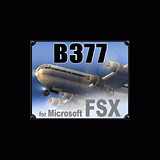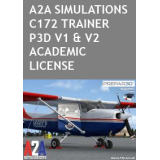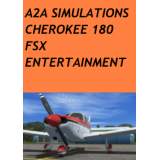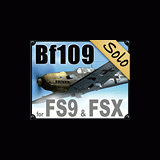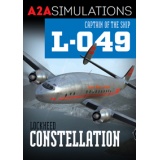Wings of POWER II: B-17G Flying Fortress – Native FSX VersionWithout a doubt, the Boeing B-17 Flying Fortress is the most-recognized and well-known aircraft to emerge from World War II. There are many reasons for this, not the least of which was an aggressive publicity campaign by the War Department, which resulted in the superb wartime classic propaganda film "Memphis Belle" (not to be confused with the modern film of the same name), and a year-long tour of the United States by the actual "Memphis Belle" and her crew.
But, despite the hype that was associated with this aircraft (Liberator crews sometimes groused about there being 11 crew members on every B-17, including a publicity officer), there were very solid reasons why the B-17 Flying Fortress holds a revered place in history and in the hearts of those who flew her. It was, first and foremost, a supremely functional and extremely rugged aircraft. No other aircraft to served during WWII has come away with as many documented cases of surviving extreme battle damage and making it home. Designed during peacetime, the aircraft was not rushed to the drawing board and emerged as wonderful aircraft to fly. The Fortress was a very stable and forgiving aircraft, truly a "pilot's aircraft" in all respects, and was a pleasure to fly. It can be trimmed to fly hands-off for any normal flight regime and, while slow to maneuver, is quite responsive to the controls for such a large craft. While aerobatics are prohibited officially, there are many documented cases of B-17s being put into spins, rolls, stalls, and other acrobatics by instructors and pilots who flew the type. Pilots who flew all of the major American bombers of WWII -- the B-17, B-24, and B29 -- state almost universally that the B-17 was a joy to fly as compared to the other types.
Production of the B-17, which totaled 12,731 of all types, was eclipsed by that of the B-24 Liberator, a later aircraft hurriedly designed with the single intention of getting as many bombs on target as possible, with little regard to aesthetics or handling characteristics. In fact, over 6,000 more Liberators were built than B-17s, a numerical advantage of 50%. To this day, however, the Flying Fortress continues to outshine the Liberator as the flagship of the United States Army Air Forces and a symbol of victory and American ingenuity and know-how. It was that kind of airplane.Pilot Comments
"The B-24 is a truck. The B-17 is an airplane.""The B-17 was designed for 200-hour pilots who came straight from the farm into flight training. It was meant to be as easy to fly as a four-engine bomber could possibly be. It's rugged, simple, and has a good temperament. It takes a lot to piss it off."
What's New for FSX
This FSX version takes advantage of many of the new features available to virtual pilots. The camera views and cockpit functionality have all been maximized for the most immersive experience possible, and the flight dynamics have been tuned to utilize the more refined handling characteristics of FSX, especially the force feedback. The Wings of POWER II B17 has been built from the ground up to take full advantage of advanced features in Microsoft Flight Simulator X, including an innovative A2A Simulations 3D light system. You will find this aircraft to be a highly immersive and realistic simulation of the real thing.
ABBREVIATED CHECKLIST
ENGINE START
- Set the parking brakes.
- Use the icons or keystrokes to view the popups or use the switches and controls in the virtual cockpit as desired or needed.
- Confirm the fuel supply is available.
- Set propeller controls to 79 percent using the mouse tooltip as a guide; this will provide 2500 RPM for takeoff with full throttle.
- Turn on the master battery switches.
- Set cowl flaps to the full open position for Engine 3.
- Set carb air intake to "FILTERED" position.
- Confirm master ignition switch is turned "ON".
- Confirm magnetos for Engine 3 are set to "BOTH".
- Turn on the boost pump for Engine 3.
- Turn ON the fuel cutoff switches for all engines (these are ganged together).
- Set the mixture for Engine 3 to "Full Rich."
- Check fuel pressure is 15 psi on copilot's panel.
- Open the throttle slightly.
- Using the start switches in the virtual cockpit on the right side, select Engine 3.
- Using the MESH/ENGAGE switch for Engine 3, first pull the switch DOWN with the mouse to mesh, and then UP to engage the starter.
- This may take one or two tries, but the engine will start immediately once the starter engages properly.
- Idle at 1,000 RPM and check for rise in oil pressure.
- Monitor engine instruments for proper range of operation.
- Turn on the Generator switch for Engine 3.
- Repeat this procedure for Engines 4,1, and 2 in that order.
- Turn on Avionics Master and set radios as desired.
TAKEOFF
Note for all aircraft: As with the actual aircraft, it is entirely possible to overboost the engines or overspeed the propeller if proper control settings are not observed. The maximum war emergency manifold pressure and propeller RPM for this aircraft substantially exceed the normal takeoff settings. Adhere to this checklist for the correct settings or this aircraft will not perform properly.
- Cowl Flaps: 1/3 Open
- Flaps: Up
- Mixture: Aircraft equipped with auto-mixture control. Set to full rich.
- Elevator trim (in Virtual Cockpit to pilot's right): Neutral
- Rudder trim (in Virtual Cockpit on floor to pilot's left): Neutral
- Aileron trim (in Virtual Cockpit on floor to pilot's right): Neutral
- Power: 46" Hg/2500 rpm
- Liftoff speed: 115 mph IAS
Apply power smoothly and gradually, walking the throttles forward evenly until reaching full takeoff power in the first 1/3 of the runway. The aircraft will have a moderate tendency to pull to the left; use right rudder or differential throttle to correct. Good rudder control is achieved by 80 mph IAS. Allow the tail to lift naturally. Take off from a two-point, tail-low attitude. The aircraft will fly itself off the runway at about 115 mph with just moderate back pressure on the controls, depending on gross weight. Retract gear as soon as a positive rate of climb is established. After reaching 140 mph IAS reduce power to rated power (38" Hg and 2300 rpm). Retract flaps before reaching 150 mph IAS. Hold the aircraft in a very shallow climb until an indicated airspeed of 150 mph is achieved.
Takeoff Distance (to clear 50' obstacle)
| Weight, pounds |
Distance, feet |
| 62,000 |
4,190 |
| 62,000 |
2,850* |
*Three-point takeoff using 1/3 flaps and full war emergency power: full throttle and 2,760 RPM.
EMERGENCY/SHORT FIELD TAKEOFF
For short field takeoff, the manifold pressure may be set to the maximum war emergency setting of 55" and the propeller governor control may be set to 2760 RPM. These represent the maximum possible propeller and throttle settings. Use 1/3 flaps and use a three point takeoff technique, climbing at full war emergency power. Do not use war emergency power for more than two minutes.
CLIMBING
Climb at an indicated airspeed of 140 mph IAS (150 mph IAS if on instruments) with a power setting of 38" of manifold pressure and 2300 rpm. For lower weights use 35" and 2300 RPM. Cowl flaps are normally set to about 1/3 open or less for climbing. Maximum cylinder head temperature is 218 degrees Celsius. This aircraft was equipped with an automatic mixture control. Therefore, no mixture adjustment is necessary.
CRUISING
The B-17 must cruise "on the step" in order to get the maximum possible range. To get "on the step" climb to at least 500 feet above your desired cruising altitude and allow the aircraft to accelerate to cruising speed while descending to the cruising altitude. Normal cruising speeds for the B-17 are 140-150 mph IAS depending on the aircraft weight and altitude. The aircraft will cruise in a slightly nose-up attitude at heavier weights and higher altitudes. The maximum cylinder head temperature is 218 degrees, 205 is desirable.
The B-17 normally cruises at a manifold pressure of about 30" and an engine RPM of 2000 or less. Use the following chart to determine the correct power condition and speed for cruise at a given aircraft weight. This aircraft was equipped with an automatic mixture control. Therefore, no mixture adjustment is necessary.
Cruise at 25,000 Feet Density Altitude
(Charts are for B-17F; figures for B-17G are approximately 2-3 percent less due to slightly higher parasite drag)
| Weight |
IAS, mph |
TAS, mph |
Boost |
RPM |
BHP |
GPH |
MPG |
| 60,000 |
140 |
207 |
30 |
2100 |
628 |
205 |
1.01 |
| 55,000 |
140 |
207 |
29 |
1900 |
578 |
188 |
1.10 |
| 50,000 |
140 |
207 |
29 |
1800 |
560 |
183 |
1.14 |
| 45,000 |
140 |
207 |
29 |
1700 |
540 |
176 |
1.18 |
Cruise at 5,000 Feet Density Altitude
| Weight |
IAS, mph |
TAS, mph |
Boost |
RPM |
BHP |
GPH |
MPG |
| 60,000 |
150 |
161 |
29 |
1650 |
520 |
170 |
0.95 |
| 55,000 |
150 |
161 |
29 |
1500 |
490 |
161 |
1.00 |
| 50,000 |
150 |
161 |
28 |
1500 |
475 |
154 |
1.04 |
| 45,000 |
150 |
161 |
27 |
1500 |
452 |
148 |
1.08 |
THE C-1 AUTOMATIC FLIGHT CONTROL SYSTEM
From the B-24 manual:
"The C-1 autopilot is an electromechanical robot which automatically controls the airplane in straight and level flight, or maneuvers the airplane in response to the fingertip control of the human pilot or bombardier. The autopilot control panel provides the pilot with fingertip controls by which he can conveniently engage or disengage the system, adjust the alertness or speed of its responses to flight deviations, or trim the system for varying load and flight conditions."
The C-1 autopilot in the Wings of Power aircraft is not as complex as the real thing, thankfully, but offers a great deal of functionality. It also duplicates some of the quirkiness of the original if used to fly the aircraft with "fingertip" controls. The autopilot front panel has the following functions:

Most of the controls work in the normal manner. The fun begins when using the autopilot in the "manual" mode. First, turn on the Master Switch located at the upper left, under the Turn Control knob. The red pilot light at the bottom left will light. This simply powers up the unit and will not engage any of the functions. Turn on the Wing Leveler and Altitude Hold and establish the airplane in level flight. Then turn on the Centering Lights power switch, located to in the upper right corner. Carefully center all the control inputs (aileron, elevator, rudder) until all the lights are illuminated. Then use the Turn Control knob (either one will work) to initiate a gentle turn. Two or three mouse-clicks are enough to start a gentle turn. Once the airplane is turning at the desired rate, use the mouse to recenter the Turn Control knob -- it helps to remember how far you turned it to begin with. The airplane will continue to turn indefinitely, and if you have used too much control, it will continue to bank, so be careful as to how much you turn the knob. A little goes a long way. As the airplane approaches the desired heading, you'll want to level out by turning the Wing Leveler switch back on, since it automatically turns off whenever you make an adjustment with the Turn Control knob. Lead your rollout by a few degrees as you would if you were flying manually, as the airplane will continue to yaw as it rolls level. This is more difficult than it sounds and it is quite satisfying to get this down pat. Like the real aircraft, the controls must be centered before this will work. You will need to recenter the controls after making a turn in this way.
The other controls work in essentially the same way as a normal autopilot but there is more manual labor involved. The Altitude Hold switch simply engages this function, but you will need to preset your desired altitude using the Altitude Hold Adjust, one click at a time. The Altitude Hold switch will not enter the current altitude for you. The Vertical Speed Adjust default is zero, so you will also need to enter your desired vertical speed manually, the plane will not automatically begin to climb or descend as with most aircraft. For an extra challenge, you can fly an ILS approach using the localizer hold only, meaning you'll have to control the throttles, trim, and rate of descent. The NAV/GPS, Approach Hold, Backcourse mode, and other switches not covered here work in the normal manner. Experiment -- this is a versatile and fun unit that will entertain for hours.
LANDING
Calculate the power-off stalling speed based on the aircraft weight. Set engines to 2100 RPM and adjust power as required to achieve an airspeed of 140-150 mph IAS. Enter the pattern at either the crosswind or downwind leg at 800-1000 feet AGL. If possible, enter the pattern on the crosswind leg and fly 2-3 miles out from the runway. This will provide ample room to maneuver the aircraft. Turn base 2-3 miles beyond the runway threshold at 145 mph IAS and lower flaps to 1/3 down and reduce airspeed to 135 mph IAS. Maintain a constant altitude on the base leg. Turn on final at this airspeed. Once on final approach, move the propeller controls to the takeoff position (2500 RPM) using the prop governor gauge as a reference. Do not lower the flaps fully until the runway is made. Maintain a glide speed of about 120 mph IAS for the final approach. Pick a point about ten feet in front of the runway threshold and line this up with the end of the nose to set the correct glidepath. A normal final approach is made with 20" of power at 120 mph with a descent rate of 500 fpm. Make a three-point landing, gliding onto the runway at this speed.
Special Features of This Aircraft
Clicking on the compass icon will bring up the co-pilot's panel.
More Information
The above procedures are abbreviated but were taken directly from the official manual issued to pilots for training purposes. This manual is now widely available. For the most realistic possible flying experience, obtain a copy of this manual and use it to fly your Wings of Power aircraft. You will find that you can use the manual to fly this virtual aircraft and it will perform exactly as specified in the original training manual.
Wings of Power Certified Specifications:
- Top Speed @ SL: 220 mph TAS (45,000 lbs)
- Top Speed @ Alt: 287 mph TAS @ 25,000 feet (45,000 lbs)
- Cruise @ 5,000 ft: 150 mph IAS/ mph TAS @ 29" Hg/1650 rpm (60,000 lbs.)
- Cruise @ 25,000 ft: 140 mph IAS/207 mph TAS @ 29" Hg/1750 rpm (60,000 lbs.)
- Climb: 38 minutes to 20,000 ft (62,000 lbs.)
- Climb: 62 minutes to 30,000 ft (62,000 lbs.)
- Fuel to climb (25,000 feet): 232 gallons
- Distance to climb (25,000 feet): 140 miles
- Takeoff distance to clear 50 feet: 4,190 feet (62,000 lbs.)
- 1 g stall speed, clean: 102 mph IAS (50,000 lbs.)
- 1 g stall speed, landing: 90 mph IAS (50,000 lbs.)
- Slow flight: stable with good rudder control up to the point of stall.
- Stall: Very mild wing drop. Recovery is routine.
- Empty weight: 36,135 lbs.
- Ramp Weight (fully equipped with oil and crew): 38,849 lbs.
- Maximum takeoff wt: 64,500 pounds
- Vmax: 270 mph IAS
- To Gear Down: mild pitch down
- To Flaps Down: mild pitch up
- Engines: Four Wright R-1820-97 air-cooled 9-cyl. radials
- Takeoff power: 1200 BHP @ 46" Hg/2500 RPM
- Emergency power: 1350 BHP @ 55" Hg/2760 RPM
- Normal climb power: 850 BHP @ 38" Hg/2550 RPM
- Max cruise power: 820 BHP/35" Hg/2300 RPM (Auto Rich)
- Normal cruise power: 610 HP/30" Hg/2000 RPM (Auto Lean)
- Fuel capacity: 3,600 gallons with bomb bay tanks
WINGS OF POWER CERTIFIED

WINGS OF POWER CERTIFIED
“Absolute Realism”
ü Unsurpassed attention to detail
ü Can be flown “by the book”
ü Gorgeously constructed aircraft, inside and out, down to the last rivet
ü Fully clickable cockpits with authentic working gauges
ü The latest wind-tunnel technology helps to create the most authentic,
fluid flying qualities, including complex spins and stalls
ü NEW 3D Lighting System
ü Bent-prop damage
ü Full 2D Panel systems
ü FSX Views
ü Authentic A2A Simulations sound for FSX
ü Realistic startup procedures, including engine mesh controls

